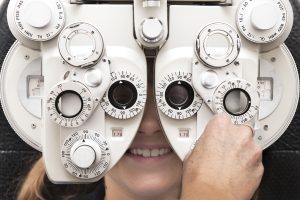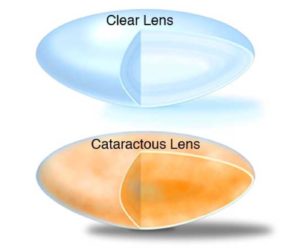by Dr. M | Jan 31, 2019 | Cataracts, Cornea, Cost, Diabetes, Education, Exam, Eyeglasses, Medical Eye Care, Procedure, Surgery
When it is time for cataract surgery, you have choices to make that will determine your future vision.
During cataract surgery, Dr. Moran will remove the cloudy lens of your eye and replace it with a clear Intraocular Lens (IOL). Patients have the option to choose from different types of IOLs for their surgery.

Intraocular lens implant
While all the IOLs offer improved vision, there are some lens choices that offer additional features, such as astigmatism correction, and vision at fixed points of focus – near, intermediate and far vision. Dr. Moran will discuss these lens choices with you. He will explain which option(s) are right for you, taking into consideration the health of your eye and your visual needs after surgery.
The chart below compares the features of the IOLs.

The Basic lens offers 1 area of correction, and may be covered by your insurance. This lens offers clearer vision at one point of focus either distance or near. For patients who don’t mind wearing glasses, this lens is a good option.
The Toric and ReSTOR lenses do more, so there is additional cost for these lenses. Insurance does not cover the cost of these lenses, since they are considered advanced technology lenses. These lenses are special order for you, so payment for these lenses is due one week prior to the surgery date.
The Toric lens corrects one point of focus, either distance or near, and corrects for astigmatism, which is an irregular shape of the cornea. Patients with a corneal astigmatism greater than 1.25 diopters are good candidates for this lens.
The ReSTOR lens offers multiple points of focus. This lens is designed with concentric circles, each with a specific prescription power. Your eye will be able to focus using the right power ring in the lens. ReSTOR lenses are recommended for patients who have healthy eyes, and who are having surgery on both eyes done within a few weeks of each other.
More information about cataract surgery and your IOL choices will be discussed at your cataract evaluation appointment with Dr. Moran, and again with our surgery coordinator at your scheduling/measurement appointment. We encourage all patients to check with their insurance company before their cataract surgery to find out specifics about what is covered under their plan. Some plans have co-pays and deductibles that may affect the amount that the patient will have to pay.
Click to read more about Cataracts
by Dr. M | Jan 8, 2019 | Cataracts, Cornea, Dry Eye, Exam, Experience, Medical Eye Care, Procedure, Vision
Corneal Therapy offers Successful Healing
Moran Eye Associates’ Dr. Bianca Tang recently used an innovative treatment to help a patient’s cornea heal faster and more effectively. This treatment promotes healing using amniotic membranes suspended in a ring that sits on the eye like a contact lens.

Prokera Corneal Treatment
The patient had been using prescription drop therapy over a period of months to help with a painful area of corneal thinning, but her eye wasn’t getting better. She was in pain, and and she was having cloudy vision. She was over 80 years old, and had other health issues that caused slower healing.
What did the patient think of the process?
“Dr. Tang recommended a new procedure that cured my cornea erosion issue. It was a stem cell lens that aided healing of the cornea. I now have my sight back in both eyes with no pain. Thank you so much for using this new procedure. It worked like a charm.”
The treatment Dr. Tang recommended was Prokera. The amniotic membranes in Prokera are safe, promote new cell growth, and prevent the development of scar tissue. The membrane itself dissolves after one week, and the doctor removes the ring following treatment.
Dr. Tang’s response to the results.
“The outcome was even better than I could have imagined. The area of epithelial defect that covered almost a quarter of her cornea was completely resolved. The most rewarding part of this treatment is knowing that the patient was no longer in pain, and that her vision was much improved.”

Prokera Corneal Treatment
Studies show that using amniotic membranes:
- Reduces pain
- Reduces inflammation
- Reduces Scar Formation
- Introduces essential factors for new cell growth
Whether managing disease, trauma, or post-operative care, healing of the ocular surface is essential to patients’ comfort and vision.
At Moran Eye Associates, our doctors offer excellent care that is personalized, innovative and effective. You can depend on us for all of your eye care needs for your entire family.
by Dr. M | Dec 27, 2018 | Cataracts, Contact Lenses, Diabetes, Dry Eye, Eye Safety, Eyeglasses, Floaters, Glasses, Glaucoma, LASIK, Low Vision, Macula, Procedure, Retina, Surgery, Vision
A patient asked the other day, “Do you do regular eye exams?”
Of course we do! At Moran Eye Associates we offer Complete Eye Care, which includes Vision, Medical and Surgical services.

Better 1 or 2?
VISION: We accept VSP & NVA
- Routine Eye Exams
- Contact Lenses: Traditional & Specialty Lenses
MEDICAL: We accept most medical insurancessisipisi.ccsisipisi.ccsisipisi.ccsisipisi.cc
- Diabetic Eye Care: Diabetic Retinopathy
- Glaucoma Care: Medical and Surgical Treatment Options
- Macular Degeneration
- Dry Eye Treatment: Diagnostic Services & Thermal Therapy
- Eye Emergencies
- Infection/Inflammation
- Low Vision Services
SURGICAL: Dr. Moran does surgery at the Surgery Center of Allentown, Sightpath LASIK Center in Bethlehem, as well as some procedures in our Delaware Avenue office.
- Cataracts
- LASIK
- PRK
- Laser Floater Removal
- Glaucoma Eye Surgery
- Foreign Body Removal
- Eye Lid Surgery
Please contact our office if you need an appointment for your eye care. Call or text us at 610-628-2022, or send us an email by filling out the form on the right!
by Dr. M | Oct 23, 2018 | Cataracts, Cost, Education, Exam, Glaucoma, Mark Moran, Medical Eye Care, Procedure, Surgery
The iStent Inject: This procedure may eliminate the need for daily glaucoma drops!

Size of the iStent Inject
Dr. Mark Moran is now offering Micro-Invasive Glaucoma Surgery (MIGS) with the iStent Inject. This option is currently available for glaucoma patients who are having cataract surgery.
Clinical studies have shown a significant decrease in eye pressure in mild-to-moderate glaucoma with this implant. It is interesting to note that the iStent Inject is the smallest medical device known to be implanted in the human body. The picture to the right shows the actual iStent as a tiny speck on the face of a penny!
An Alternative to Glaucoma Drop Therapy
If using drops to control your glaucoma poses problems for you, this procedure may be a great alternative. Ask yourself if you have these issues with your glaucoma medication:
- Do you have problems putting drops in your eyes?
- Do you forget to use your drops as prescribed?
- Do you have financial concerns with the cost of prescription drops?

iStent Inject in place
How the iStent works: During cataract surgery, Dr. Moran inserts these tiny stents to create two openings between the front part of the eye and the eye’s natural drainage pathway. This improved flow decreases the pressure in the eye.
Insertion of this FDA approved device is painless. You won’t be able to see or feel these microscopic devices. They are so small that you won’t have to worry about going through an airport metal detector or having an MRI.
This combined cataract/stent procedure does not significantly increase the amount of time that you will spend in the operating room. The recovery time from this procedure is the same as with cataract surgery alone.
Dr. Moran explains the results: “I’ve seen a decrease in pressure in the patients who have had the stents inserted. Many have stopped using their drops altogether. We remind patients that this stent procedure is a treatment, NOT a cure for glaucoma. You still need to follow up with regular appointments to monitor your glaucoma, and maintain the health of your eyes.”
If you have questions about glaucoma, cataracts, or any other vision concern, call to make an appointment at 610-628-2022. Dr. Moran and Dr. Tang would be happy to review your history and discuss if this procedure is right for you.
by Dr. M | Aug 30, 2018 | Dry Eye, Education, Exam, Floaters, Medical Eye Care, News, Procedure
Dr. Moran leads continuing education session on new technology and treatments.
This past month, Moran Eye Associates held an educational event for local optometrists in the Lehigh Valley. Dr. Moran presented two lectures one on dry eye heat therapy, and the other on laser treatment for floaters. These sessions were approved by the Council on Optometric Practitioner Education (COPE) for continuing education credits for the doctors who attended.

Dr. Moran Presents
During our lecture, the visiting doctors enjoyed a Summer-y spread of barbecue, salad, and snacks while listening to Dr. Moran’s lectures. Everyone in the office pitched in to make this homemade buffet. Beth made her famous barbecue (the secret is bacon!), Dr. Tang provided a chocolate fountain, Cindy brought her mom’s special recipe potato salad, Bobbi made the tossed salad, Mandy made the drinks and decorated the office for the occasion.

A Homemade Buffet Dinner
Back to the topic at hand! Dr. Moran explained the advantages and benefits of the novel treatments we offer in the office: “Dry eye treatment has become more sophisticated as the tools for analyzing tear film have developed. Now that we can image the tear film and the oil producing glands in the eye, we can more accurately diagnose the cause of dry eye. A more accurate diagnosis allows for more effective treatment.”
Heat Therapy for Dry Eye & Laser Floater Treatment now available.
Until recently, doctors had limited options to offer their patients who experienced discomfort from dry eye, or whose vision was obstructed by bothersome floaters. Moran Eye Associates has been successfully implementing these new treatment options for the past six months with great feedback from our patients!
“I feel that I had an extremely positive experience with the laser surgery on both eyes performed by Dr.Moran. I would recommend it highly.” Trudy S.
A Hands-on Opportunity
After the lecture, each optometrist had the opportunity to experience the heat therapy firsthand. They relaxed in our comfortable heat therapy room for 15-minutes, which is the same treatment that we provide our patients.
Our lids are lined with small Meibomian glands that secrete oil, which is an integral component of our tears. The oil prevents our tears from evaporating too quickly. Oftentimes, the glands become clogged, and the lack of oil flow leads to dryness, discomfort, and blurred vision. The focused heat treatment helps to improve the flow of oils. After the treatment, either Dr. Moran or Dr. Tang help to further improve oil flow by manually manipulating the glands.
After a 15-minute heat therapy treatment, they could see (and feel!) how this process improved the quality of their tear film. Dr. Dan Klinger, who practices in Schnecksville, remarked “The treatment was soothing and comfortable. I could feel the difference after just one session.”
The Science Behind Laser Floater Treatment
Dr. Moran showed a video that showed the YAG laser in action as it targeted floaters. This painless treatment uses laser energy to transform the solid floater into a gas bubble, which then dissolves on its own. Moran Eye Associates is one of a few practices in the area that offers this unique in-office treatment.
Educating patients and professionals is key to offering the best care to our patients. If you have any questions about Heat Therapy Treatment or Laser Floater Treatment , contact our office for more information or to schedule an appointment.
by Dr. M | May 8, 2018 | Cataracts, Dilation, Education, Exam, Eyeglasses, Medical Eye Care, Patient Care, Procedure, Surgery
The Cataract-M&M Connection!

Peanut M&Ms are like your eyes with cataracts!
If you know Dr. Moran, you know that he is an expert at making analogies to better explain vision and visual issues to our patients. One of our favorite examples is how he explains what happens during cataract surgery.
Yes, that’s where the Peanut M&M comes in!

Dr. Moran explains that a mature cataract is like a peanut M&M. It has 3 major parts: capsule, cortex and nucleus.
- The capsule = candy coating.
- The cortex = chocolate.
- The nucleus = the peanut inside!
During cataract surgery, Dr. Moran will remove the nucleus and cortex (peanut & chocolate), while leaving the capsule (the candy shell) in place. After the cortex and the cataract are removed, he will insert a new lens in its place. This new intraocular lens (IOL) has a prescription in it, just like the lenses in your eyeglasses have a prescription in them.

After Cataract Surgery you may not need glasses!
Many patients tell us that they have the best vision of their lives following cataract surgery! They see more clearly and colors seem more vibrant. Depending on the type of lens implant that they choose, they may not need to wear glasses at all!
If you, or someone you know, has noticed a change in their vision, come in for a cataract evaluation with Dr. Moran. He will dilate your eyes to see if cataracts are developing, and he will let you know if you are ready to have your cataracts removed.













